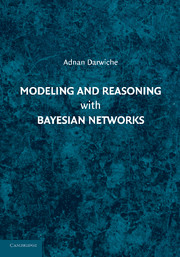Book contents
- Frontmatter
- Contents
- Preface
- 1 Introduction
- 2 Propositional Logic
- 3 Probability Calculus
- 4 Bayesian Networks
- 5 Building Bayesian Networks
- 6 Inference by Variable Elimination
- 7 Inference by Factor Elimination
- 8 Inference by Conditioning
- 9 Models for Graph Decomposition
- 10 Most Likely Instantiations
- 11 The Complexity of Probabilistic Inference
- 12 Compiling Bayesian Networks
- 13 Inference with Local Structure
- 14 Approximate Inference by Belief Propagation
- 15 Approximate Inference by Stochastic Sampling
- 16 Sensitivity Analysis
- 17 Learning: The Maximum Likelihood Approach
- 18 Learning: The Bayesian Approach
- A Notation
- B Concepts from Information Theory
- C Fixed Point Iterative Methods
- D Constrained Optimization
- Bibliography
- Index
14 - Approximate Inference by Belief Propagation
Published online by Cambridge University Press: 23 February 2011
- Frontmatter
- Contents
- Preface
- 1 Introduction
- 2 Propositional Logic
- 3 Probability Calculus
- 4 Bayesian Networks
- 5 Building Bayesian Networks
- 6 Inference by Variable Elimination
- 7 Inference by Factor Elimination
- 8 Inference by Conditioning
- 9 Models for Graph Decomposition
- 10 Most Likely Instantiations
- 11 The Complexity of Probabilistic Inference
- 12 Compiling Bayesian Networks
- 13 Inference with Local Structure
- 14 Approximate Inference by Belief Propagation
- 15 Approximate Inference by Stochastic Sampling
- 16 Sensitivity Analysis
- 17 Learning: The Maximum Likelihood Approach
- 18 Learning: The Bayesian Approach
- A Notation
- B Concepts from Information Theory
- C Fixed Point Iterative Methods
- D Constrained Optimization
- Bibliography
- Index
Summary
We discuss in this chapter a class of approximate inference algorithms which are based on belief propagation. These algorithms provide a full spectrum of approximations, allowing one to trade-off approximation quality with computational resources.
Introduction
The algorithm of belief propagation was first introduced as a specialized algorithm that applied only to networks having a polytree structure. This algorithm, which we treated in Section 7.5.4, was later applied to networks with arbitrary structure and found to produce high-quality approximations in certain cases. This observation triggered a line of investigations into the semantics of belief propagation, which had the effect of introducing a generalization of the algorithm that provides a full spectrum of approximations with belief propagation approximations at one end and exact results at the other.
We discuss belief propagation as applied to polytrees in Section 14.2 and then discuss its application to more general networks in Section 14.3. The semantics of belief propagation are exposed in Section 14.4, showing howit can be viewed as searching for an approximate distribution that satisfies some interesting properties. These semantics will then be the basis for developing generalized belief propagation in Sections 14.5–14.7. An alternative semantics for belief propagation will also be given in Section 14.8, together with a corresponding generalization. The difference between the two generalizations of belief propagation is not only in their semantics but also in the way they allow the user to trade off the approximation quality with the computational resources needed to produce them.
- Type
- Chapter
- Information
- Modeling and Reasoning with Bayesian Networks , pp. 340 - 377Publisher: Cambridge University PressPrint publication year: 2009

